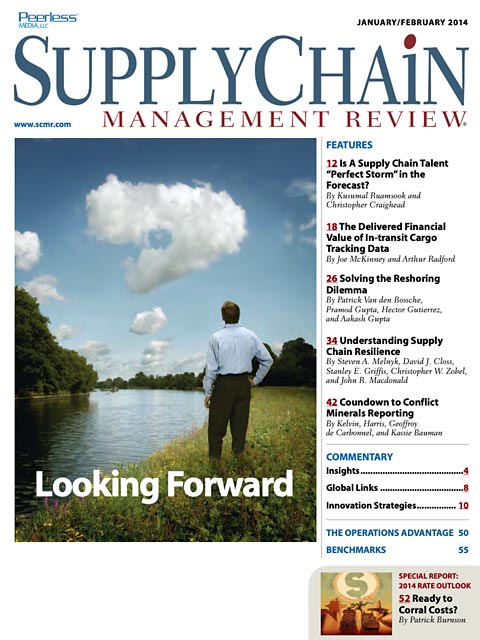Sorry, but your login has failed. Please recheck your login information and resubmit. If your subscription has expired, renew here.
January-February 2014
With the demands for more skilled supply chain professionals, the silver tsunami of retiring workers, and a shortage of supply chain students and instructors, a perfect storm may be brewing. Penn State authors Kusumal Ruamsook and Christopher Craighead outline the factors that may limit the pool of supply chain talent and offer five strategies to help weather the storm. Get this issue to learn more. Browse this issue archive.Need Help? Contact customer service 847-559-7581 More options
In The Perfect Storm, Sebastian Junger chronicled the story of the six crew members on board the Andrea Gail, a swordfish boat out of Gloucester, as they battled a once-in-a-century meteorological cataclysm off the coast of Newfoundland in October 1991.
The devastating storm was created by the confluence of three extreme meteorological forces: an icy cold high pressure system, a low pressure system, and the remnants of tropical Hurricane Grace. It was a colossal winter-summer collision of an Arctic storm and a tropical hurricane. When the low pressure system met the high pressure system, they formed a non-tropical Atlantic storm that later absorbed Hurricane Grace. Such events are rare, but when they happen, they bring forth enormous amounts of destructive energy. During
The Perfect Storm, gale force winds “blasted over the ocean at more than 100 mph. Ocean waves peaked at 100 feet, the height of 10-story buildings,” wrote Beth Nissen, a reporter for CNN.com. As anyone who has read the book or seen the movie knows, the ship and crew succumbed to the power of the wind and waves.
Based on our research, which was supported by the Center for Supply Chain Research (CSCR) at the Smeal College of Business, at The Pennsylvania State University, we believe a supply chain talent perfect storm could be in the offing. Our conclusions were drawn from a review of the literature, reports from key organizations, and a Supply Chain Leaders Forum (SCLF) sponsored in October 2012 by CSCR. The Leaders Forum brought together more than 70 top supply chain and human resource professionals from a variety of companies and industries to address the challenges stemming from supply chain talent.
 |
This complete article is available to subscribers
only. Click on Log In Now at the top of this article for full access. Or, Start your PLUS+ subscription for instant access. |
Not ready to subscribe, but need this article?
Buy the complete article now. Only $20.00. Instant PDF Download.
Access the complete issue of Supply Chain Management Review magazine featuring
this article including every word, chart and table exactly as it appeared in the magazine.
SC
MR
Sorry, but your login has failed. Please recheck your login information and resubmit. If your subscription has expired, renew here.
January-February 2014
With the demands for more skilled supply chain professionals, the silver tsunami of retiring workers, and a shortage of supply chain students and instructors, a perfect storm may be brewing. Penn State authors Kusumal… Browse this issue archive. Access your online digital edition. Download a PDF file of the January-February 2014 issue.| Click here to download PDF of the full article. |
In The Perfect Storm, Sebastian Junger chronicled the story of the six crew members on board the Andrea Gail, a swordfish boat out of Gloucester, as they battled a once-in-a-century meteorological cataclysm off the coast of Newfoundland in October 1991.
The devastating storm was created by the confluence of three extreme meteorological forces: an icy cold high pressure system, a low pressure system, and the remnants of tropical Hurricane Grace. It was a colossal winter-summer collision of an Arctic storm and a tropical hurricane. When the low pressure system met the high pressure system, they formed a non-tropical Atlantic storm that later absorbed Hurricane Grace. Such events are rare, but when they happen, they bring forth enormous amounts of destructive energy. During
The Perfect Storm, gale force winds “blasted over the ocean at more than 100 mph. Ocean waves peaked at 100 feet, the height of 10-story buildings,” wrote Beth Nissen, a reporter for CNN.com. As anyone who has read the book or seen the movie knows, the ship and crew succumbed to the power of the wind and waves.
Based on our research, which was supported by the Center for Supply Chain Research (CSCR) at the Smeal College of Business, at The Pennsylvania State University, we believe a supply chain talent perfect storm could be in the offing. Our conclusions were drawn from a review of the literature, reports from key organizations, and a Supply Chain Leaders Forum (SCLF) sponsored in October 2012 by CSCR. The Leaders Forum brought together more than 70 top supply chain and human resource professionals from a variety of companies and industries to address the challenges stemming from supply chain talent.
Click here to download PDF of the full article.
SC
MR

Latest Supply Chain News
- Services sector sees growth in October, reports ISM
- Balanced supply chain management Part 4: The key—leading beyond the silo
- Managing inbound freight: What has changed in two decades?
- Inbound freight: Often a missed opportunity
- Aggregators sitting on the throne of Africa’s e-commerce supply chains: What lessons can we learn?
- More News
Latest Resources

 Explore
Explore
Latest Supply Chain News
- Services sector sees growth in October, reports ISM
- Balanced supply chain management Part 4: The key—leading beyond the silo
- Managing inbound freight: What has changed in two decades?
- Inbound freight: Often a missed opportunity
- Aggregators sitting on the throne of Africa’s e-commerce supply chains: What lessons can we learn?
- Cross-border transport 2024: Navigating the surge
- More latest news
Latest Resources

Subscribe

Supply Chain Management Review delivers the best industry content.

Editors’ Picks





